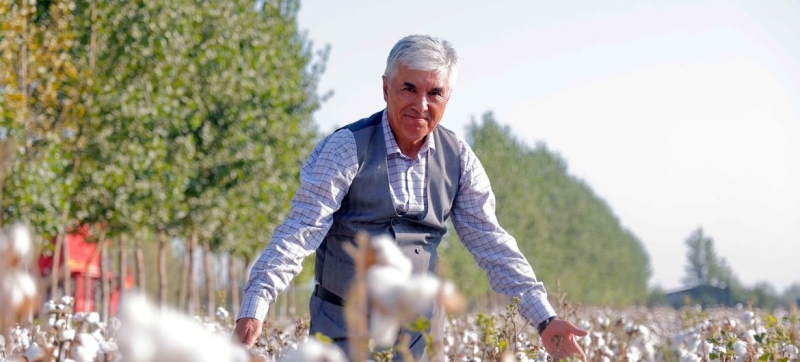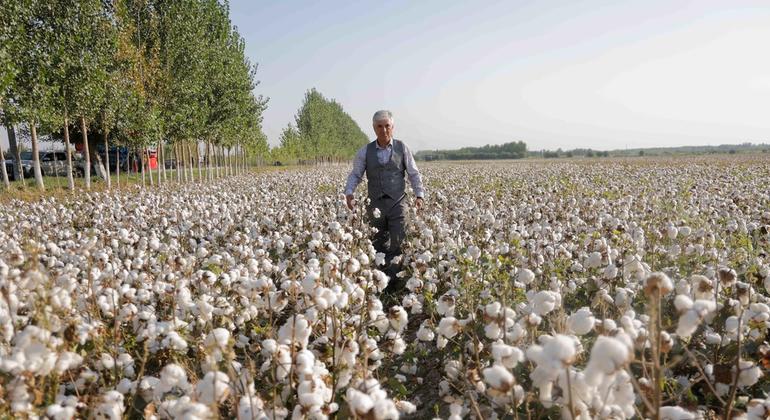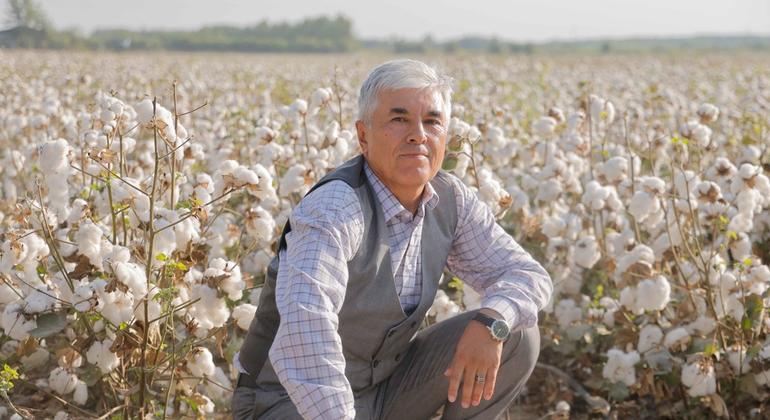
Cotton has been cultivated in Central Asia since the 3rd-4th centuries BC. Cotton Day: the latest technologies are used in the production of “white gold” in Central Asia Kulpash Konyrova Economic development
Cotton is traditionally grown in Uzbekistan and southern Kazakhstan, and over the past decades, scientists and breeders have made great strides in creating early-ripening seeds, which allows for increased production volumes. The report from these countries is timed to coincide with World Cotton Day, which is celebrated on October 7.
“Before” and “After”
The end of September is a busy time for cotton growers in Uzbekistan. This is the time when the seeds sown in the spring should yield the long-awaited harvest. 55-year-old farmer Pazildina Saifutdinov has a 75-hectare plot in the Yazavan district of the Fergana region, from which he plans to receive a good income by local standards from the sale of the grown cotton this year: no less than 150 thousand dollars.
The farmer’s confidence is well-founded. Over the past seven to eight years, the authorities of this Central Asian republic have announced radical reforms in the industry, which has a centuries-old history.
“Thanks to the foreign equipment we have, we collect 50,000 tons of cotton a day in our fields. And if earlier I would have needed at least 500-1,000 workers to achieve such volumes, today I can get by with a team of 20 people,” Pazildin Saifutdinov told the UN News Service.
The cotton fields, despite the harvest season, looked sparsely populated. Huge combines and trucks moved sedately between the white rows of cotton bushes.

Saifutdinov recalled that even before 2016, there was an embargo on one of Uzbekistan’s main export commodities – cotton. This was due to the fact that child labor was used during the harvest: “As a schoolboy, I myself, together with my classmates, worked in the fields every year. Now this is out of the question. This practice is a thing of the past. And all this is thanks to a number of steps taken by the government, which are aimed at supporting cotton growers who have decided to switch to innovative methods in cotton production.”
According to the International Labour Organization (ILO) data published in 2021, two million children have been freed from child labour and half a million adults from forced labour since Uzbekistan began reforming its cotton sector.
According to the ILO report on monitoring the cotton harvest in Uzbekistan, based on eleven thousand interviews with cotton pickers, 99 percent of those involved in the 2021 cotton harvest worked voluntarily. There were very few or no cases of forced labour in all provinces and districts.
Pazildin Saifutdinov has been working in the cotton sector for 35 years, since he received a degree in irrigation engineering. He can compare how it was before and after the reform. Today, the country’s cotton growers rely on new technologies and develop cooperation with colleagues from other countries of the world.
“It is in recent years that there has been a rapid breakthrough in the development of cotton growing. For example, Uzbekistan is a trans-border country; the Amu Darya and Syr Darya rivers carry their waters to us through Afghanistan and Tajikistan. Therefore, for us, the issue of economical use of water is one of the most important. Today, using drip irrigation technology, we have managed to halve water consumption for growing cotton – from 7.5 to 3.5 cubic meters per hectare. The state provides cotton growers with good subsidies for the introduction of this innovation,” shared Pazildin Seyfutdinov.
Financial support is also provided for the purchase of combines for harvesting cotton and dump trucks for their transportation.

New varieties
Uzbek breeders also make a significant contribution to cotton production, having managed to develop about 40 varieties of cotton, of which more than 20 are early maturing, which is a very serious factor for a heat-loving crop, given the local climate.
“Cotton growing occupies an important place in the structure of the economy of Uzbekistan. Despite the fact that cotton has been cultivated in our country since the 3rd-4th centuries BC, it has been in recent years that a major breakthrough has occurred thanks to the new policy of the authorities,” Shadman Namazov, academician and director of the Research Institute of Selection, Seed Production and Agrotechnology of Cotton Growing, told the UN News Service.
Two years ago, the scientific organization he heads celebrated its 100th anniversary. Over the years, Uzbek breeders have created new varieties of this crop, which, despite the short ripening period, retain the high quality of the fibers.
“In Uzbekistan, about 40 varieties are recognized as promising, and over 20 of them are early ripening. “They are used to sow about 80 percent of cotton fields, the total area of which is just over one million hectares,” the expert said.
According to him, Uzbek breeders share their achievements with their neighbors in the region: Turkmenistan, Tajikistan and Kazakhstan.
In Uzbekistan, Namazov continued, a local exchange has been created where Uzbek farmers can sell their goods at a favorable price. Among the buyers are representatives of local cotton-textile clusters. The enterprises process raw materials and produce finished goods, which are also exported to other countries. Part of the reform of the industry was precisely to trade not raw materials, but higher-quality products.

Kazakhstan’s “White Gold”
In the south of Kazakhstan, cotton production provides jobs for over a million people. “Despite the fact that “white gold” provides ten or even fifteen times less income to the country’s budget than “black” gold – oil, this crop will remain one of the most important in the south of the republic: the industry provides jobs for over one million people in our region,” Nurman Daurenbek, director of the Agricultural Experimental Station for Cotton and Melon Growing, told the UN News Service.
Cotton has also been grown in nine districts of Kazakhstan’s Turkestan region for centuries. The total area of this crop here exceeds 100 thousand hectares.
“If last year we sowed 116 thousand hectares for cotton, then this year only 106. Previously, this figure was 180 thousand hectares. The reason for the reduction in areas is almost entirely due to a lack of water,” said Nurman Daurenbek.
He explained that Kazakhstan receives water from the Toktygul Reservoir in Kyrgyzstan. Water for irrigation goes to Kazakhstan through three neighboring countries: Kyrgyzstan, Tajikistan and Uzbekistan.
“Instead of the required 100 cubic meters, we receive 80. Everything depends on how much water the Toktogul Reservoir can collect over the winter. But a water deficit is not a reason to give up, but an incentive to look for new ways to solve the problem,” the station director believes. – For example, we see this in the introduction of drip irrigation and covering fields with special film after sowing to retain moisture, as well as in the development of new, higher-yielding varieties of cotton.”
According to him, today 80 percent of all cotton fields in the Trukestan region are equipped with drip irrigation systems. In addition, farmers receive subsidies for fertilizers and preferential loans for the purchase of equipment, and also have the opportunity to purchase diesel fuel at a low price.
Local authorities also plan to create cotton-textile clusters in the region, which should help with the sale of products by Kazakh cotton growers.
In addition, Kazakhstan and Uzbekistan decided to install 10 hydroposts on the Syr Darya River, which will help account for water consumption and prevent leaks.
